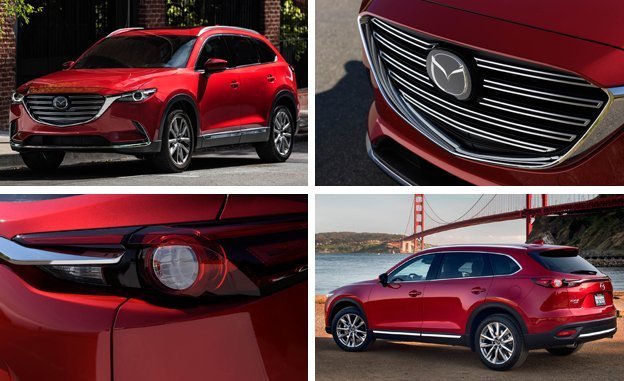The new Mazda CX-9 occupies a class of vehicles that often come up a bit short on style, even though that’s ostensibly the reason why many buyers are choosing a three-row crossover over a much more spacious and practical minivan. The need for passenger and cargo space tend to drive body-side sheetmetal that’s more upright and a roofline that plunges less dramatically, if much at all. And these competing priorities tend to water down the elegance of these vehicles, where functionality is so mission critical.
Upscale Style
That’s where the CX-9 sets itself apart. It’s the Karl Lagerfeld of a mom-jeans segment. Redone from bumper to bumper, the CX-9 borrows some cues from the CX-5 but also seemingly cribs a few styling flourishes from the Infiniti QX70. The CX-9 looks fantastic, especially on the optional 20-inch wheels. Covered in the eerie glow of Machine Gray paint, it looks expensive enough to wear a luxury-brand badge. Infiniti’s three-row QX60 and Acura’s MDX look plain by comparison.
It’s the same story inside. Material quality is excellent throughout. Many of the plastics are so finely grained and soft to the touch that they appear to be bovine based. As in all Mazdas, there are round analog dials, but unlike the binnacles in other Mazdas, one of the round housings actually contains a color LCD screen that can display trip information, a compass, and navigation directions.
There are four trim levels, and all-wheel drive is an $1800 option on all of them except for the top-dog Signature, on which it’s standard. At the bottom is the Sport ($32,420), which comes with LED headlights and taillights, cloth seats, 18-inch wheels, a backup camera, and Mazda’s 7.0-inch touchscreen infotainment system with a knob controller just in front of the center armrest. Mazda, like Audi, is smart enough to put the volume knob next to the controller.
Moving up to Touring ($36,870) brings leather seats, blind-spot monitoring, rear cross-traffic alert, power front seats, a power liftgate, an auto-dimming rearview mirror, and an 8.0-inch touchscreen. A Premium package ($1745) adds a 12-speaker Bose stereo, rain-sensing wipers, satellite radio, and a sunroof.
The next rung up is the Grand Touring trim level ($41,070), which brings 20-inch wheels, a head-up display, lane-departure warning, lane-keeping assist, adaptive cruise control with forward-collision warning and automated emergency braking, automatic high-beams, and aluminum interior trim.
The top-spec Signature ($44,915) dresses up the interior with rosewood accents and brick-colored nappa-leather seats. On the outside, the Signature gets an LED-lit grille frame. Even fully loaded at $44,915, the CX-9 remains a good value in a world where the Honda Pilot Elite costs $47,470 and the 2017 Ford Explorer Platinum goes for $54,180.
In the second row, there’s ample space for adults, provided they slide the split bench all the way back. But second-row legroom comes at the expense of third-row space. The second row moves forward to allow for entry to the rear, but the Pilot, the Explorer, and the Toyota Highlander all make it easier. The competition also beats the CX-9’s third row for spaciousness. The Mazda’s is pretty much only for kids, whereas the rear seats in the Highlander, Pilot, Explorer, Kia Sorento, and Hyundai Santa Fe work slightly better for adults.
Doing More with Four
Another major difference between the CX-9 and its competition is under the hood. While most in this class offer V-6 power, the CX-9 comes only with a turbocharged four-cylinder. The engine displaces 2.5 liters and makes 250 horsepower on premium fuel and 227 horsepower on regular. Mazda claims to have studied how buyers use their three-row mobiles and found that they almost never rev the engine past 4500 rpm, which seems reasonable. In the real world, these drivers spend most of their time at about 2000 rpm. So, to provide punch where owners want it, the CX-9’s engine makes 310 lb-ft of torque at 2000 rpm regardless of octane. There’s a nice shove from low revs, and it gives the big CX-9 the ability to squirt into holes in traffic. Keep the right pedal pinned, and the urge tapers off noticeably. It doesn’t fall away as abruptly as does a turbo-diesel, but there’s a noticeable drop in pulling power as the engine spins to its upper reaches.
To combat turbo lag, the engine has what Mazda calls the Dynamic Pressure Turbo System that combines the advantages of variable-vane and twin-scroll turbocharger technologies in one small part. There are three butterfly valves positioned in the exhaust manifold at the entrance to the turbocharger. Below 1620 rpm, these valves are closed, forcing exhaust gases through restricted paths, thereby raising the pulsation energy of the exhaust impacting the turbine wheel (like a thumb over a water hose). At 1620 rpm, when the exhaust volume is large enough, the valves open, and the turbo operates normally.
Upstream of the three valves, the integral exhaust manifold joins the two inner cylinders in one branch and the two outer cylinders in another. This arrangement facilitates scavenging—the flow from one cylinder helping draw exhaust out of the other cylinder sharing that branch. Mazda’s exhaust plumbing is quite effective at maximizing output while minimizing turbo lag. Throttle response is satisfyingly instant, even from a stop.
Mazda’s four-cylinder is 132 pounds lighter than its predecessor’s 3.7-liter V-6. The company claims overall curb weight is down 269 pounds for front-drive models (to 4054 pounds) and 258 pounds for all-wheel-drive versions (4301 pounds)—despite a heavier-gauge floorpan, 53 pounds of sound insulation between the floor and the carpet, and double-paned front-window glass. It’s quiet inside, where road noise is faint and engine noise fainter.
Efficiency Talk
The downsized engine and lighter weight help boost EPA city/highway fuel-economy numbers from last year’s 16/22 mpg (AWD) and 17/24 (front-drive) to 21/27 mpg for all-wheel-drive versions and 22/28 mpg with front-drive. Those numbers take the CX-9 to the head of the class—although the Explorer with its optional 2.3-liter turbo four and the Kia Sorento with its base 2.4-liter four come close. In the interest of real-world fuel economy, Mazda also fits an exhaust-gas-recirculation (EGR) cooler to the engine, which helps reduce combustion temperatures without the usual method of squirting in additional fuel. When on boost, turbos consume more fuel to match the extra air entering the engine and to cool combustion, but cooling the EGR system helps keep temps down. Mazda tells us that while the system’s benefits don’t show up on the light-throttle, almost-no-boost EPA test, there allegedly will be a benefit in real-world circumstances.
In that real world, the CX-9 is smooth and charismatic. Few drivers will push a CX-9 very hard, but it handles admirably with nicely controlled body roll and light but accurate steering. Mazda calls its many safety systems i-Activsense. Radar-based active cruise control comes on Grand Touring and Signature models and adds a very sensitive collision-warning system that will apply the brakes aggressively if it senses an imminent collision. Twice in two days of driving, this system thought a crash was imminent when it clearly was not. It slammed on the brakes when we were gradually slowing for a red light and again when we were changing lanes to pass a slow-moving car. The system can be shut off and its sensitivity can be adjusted (both times when we saw the system intervene, it was set to its least sensitive mode), but it automatically turns on every time the engine is started. Such an overly active system seems glaringly out of phase with Mazda’s driver-centric philosophy.
Remember to turn off the jumpy collision-warning system, and the CX-9 is an excellent three-row crossover. It doesn’t have the third-row space of some competitors, but it is more stylish, promises to be more efficient, and is more entertaining and rewarding to drive than the rest of the three-row herd.
Powered by WPeMatico







